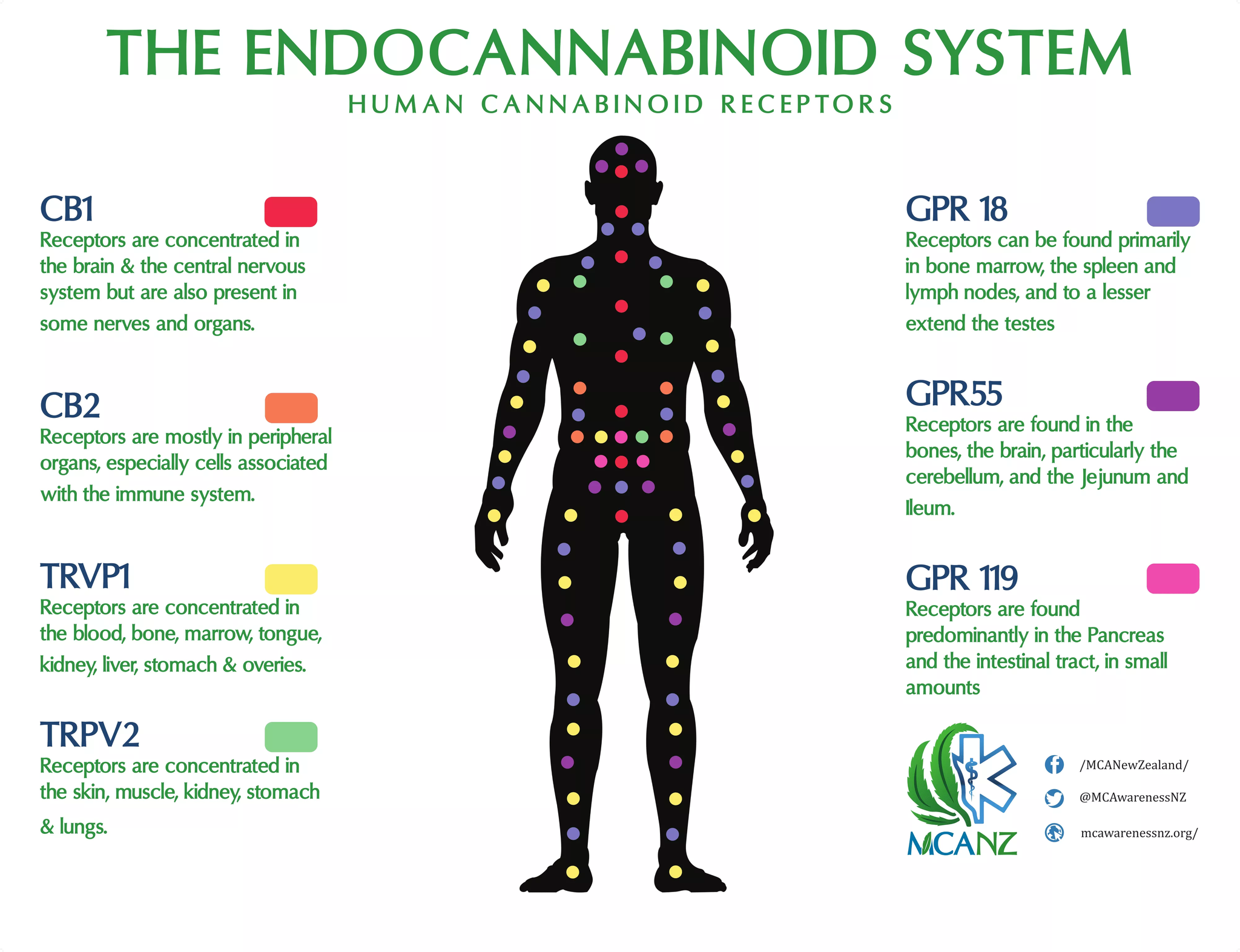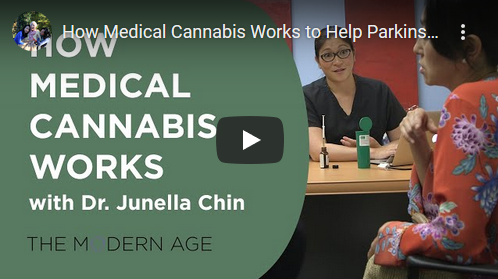Cannabis and Parkinson's Disease
Endocannabinoid receptors exist throughout the body including the brain, spinal cord, and peripheral nerves which control our body’s muscular movements [4]. In the brain, located primarily

at the cortex, cerebellum, basal ganglia, hippocampus, spinal cord, and peripheral nerves are where the CB1 and CB2 receptors are located [4]. The most common in humans (mammalian brains in general) is the CB1 receptor, located in much of our peripheral tissues and cells [2]. CB1 receptors are located primarily in the central nervous system and CB2 receptors have more influence on the immune system providing additional benefits [4]. The CB1 and CB2 receptors are responsible for controlling muscular movements and have the potential for an abundance of uses including being used as an anti-epileptic, antipsychotic, anti-oxidant, and its neuroprotective properties [4]. Many of the studies show that cannabis-based therapies may help reduce neurodegeneration[5]. In 2003 the U.S. Health and Human Services began to list the use of cannabinoids useful in certain neurodegenerative diseases such as PD, Alzheimer’s disease and dementia caused by human immunodeficiency virus[5].
Despite clinical trials being limited, the research that has been concluded about cannabis’ biology shows that THC and CBD may be able to curve certain issues associated with PD including tremors, stiffness, insomnia, dystonia, pain, dyskinesias or weight loss by stimulating appetite [6]. In two published studies about PD patients, it was found that smoked cannabis was reported to produce some benefit on motor and nonmotor symptoms [8]. In another small open-label study it was shown that within 30 minutes after consuming cannabis there was reported improvement in tremor, rigidity, bradykinesia, pain, and sleep [8]. Unfortunately, Parkinson’s symptoms can even extend past the aforementioned motor functions including inducing psychosis in the patient.
According to the American Parkinson Disease Association, more than half of all patients with Parkinson’s disease eventually develop symptoms of psychosis [8]. The American Parkinson Disease Association points out that “ a non-motor symptom of Parkinson’s disease that causes patients to experience hallucinations and/or delusions. More than half of all patients with Parkinson’s disease eventually develop symptoms over the course of their disease” [9]. Though research about cannabis and Parkinson’s is limited, many studies are showing the benefits of CBD. One study is a small 4-week open-label study of CBD for psychosis in PD which found that their symptoms were improved on the Brief Psychiatric Rating Scale and Parkinson Psychosis Questionnaire [8]. Unfortunately due to cannabis’ questionable legal status, there isn’t enough research to be able to conclusively state whether the benefits are fully from cannabis or other variables.
Doctors around the United States have been advocating for cannabis research and educating their patients about benefits and potential side effects. Dr. Junella Chin is one such doctor pioneering medical cannabis in New York . Her patient list consists of people with a range of symptoms. Dr. Chin explains, "Parkinson's was one of the first things that had passed in New York because it worked so well for muscle spasms, the contractions, the constipation, and the overall anxiety that comes with

As is true with holistic remedies, especially when looking towards cannabis therapy for PD, there are a lot of unscientific responses that simply cannot lead to definitive results. With the current information available and cannabis’ multitude of effects, including unexplored phytocannabinoids, it is difficult to generalize the need for each individual [4]. Some people react adversely to psychoactive components of THC making it a potential side effect including fatigue, dizziness, nausea, xerostomia (dry mouth), anxiety, headache, visual changes, impaired cognition, cough, and/or palpitations [8]. There are no current deaths associated with overuse of cannabis and many patients believe that the benefits outweigh the potential unwanted side effects of THC. Cannabis needs to be explored further, but it is showing to be a powerful aid in reducing symptoms associated with Parkinson’s Disease and drastically improving quality of life.
References
[1] Downward, Emily, and Jessica Johns Pool. “How Common Is Parkinson's Disease?”
ParkinsonsDisease.net, Sept. 2019, parkinsonsdisease.net/basics/statistics/.
[2] Pacher, Pál, et al. “The Endocannabinoid System as an Emerging Target of
Pharmacotherapy.”
Pharmacological Reviews, U.S. National Library of Medicine, Sept. 2006, https://www.ncbi.nlm.nih.gov/pmc/articles/PMC2241751/pdf/nihms38123.pdf.
[3] Zou, Shenglong, and Ujendra Kumar. “Cannabinoid Receptors and the Endocannabinoid
System: Signaling and Function in the Central Nervous System.” International Journal of Molecular Sciences, MDPI, 13 Mar. 2018, www.ncbi.nlm.nih.gov/pmc/articles/PMC5877694/.
[4] Mohanty, Dishka, and Steven Lippmann. Marijuana for Parkinson's Disease ?
Innovations In Clinical Neuroscience , 2019, www.ncbi.nlm.nih.gov/pmc/artic... .
[5] Kluger, Benzi, et al. “The Therapeutic Potential of Cannabinoids for Movement
Disorders.” Movement Disorders : Official Journal of the Movement Disorder Society, U.S. National Library of Medicine, Mar. 2015, https://www.ncbi.nlm.nih.gov/pmc/articles/PMC4357541/pdf/nihms649683.pdf/.
[6] Gilbert, Rebecca. “Medical Marijuana and Parkinson's Disease.” APDA, 19 Nov. 2019,
www.apdaparkinson.org/article/medical-marijuana-and-parkinsons-disease/.
[7] Modern Aging - Holistic Health and Wealth After 50.“How Medical Cannabis Works to
Help Parkinson's Disease Patients.” YouTube, commentary by Dr. Junella Chin, 07 Mar. 2019,
[8] Stampanoni Bassi, Mario, et al. “Cannabinoids in Parkinson's Disease.” Cannabis and
Cannabinoid Research, Mary Ann Liebert, Inc., 1 Feb. 2017, www.ncbi.nlm.nih.gov/pmc/artic... .
[9] “23 Parkinson's Symptoms to Look For.” APDA,
www.apdaparkinson.org/what-is-parkinsons/symptoms/.
[1] Downward, Emily, and Jessica Johns Pool. “How Common Is Parkinson's Disease?”
ParkinsonsDisease.net, Sept. 2019, parkinsonsdisease.net/basics/statistics/ .
[2] Pacher, Pál, et al. “The Endocannabinoid System as an Emerging Target of
Pharmacotherapy.”
Pharmacological Reviews, U.S. National Library of Medicine, Sept. 2006, https://www.ncbi.nlm.nih.gov/pmc/articles/PMC2241751/pdf/nihms38123.pdf.
[3] Zou, Shenglong, and Ujendra Kumar. “Cannabinoid Receptors and the Endocannabinoid
System: Signaling and Function in the Central Nervous System.” International Journal of Molecular Sciences, MDPI, 13 Mar. 2018, www.ncbi.nlm.nih.gov/pmc/articles/PMC5877694/.
[4] Mohanty, Dishka, and Steven Lippmann. Marijuana for Parkinson's Disease ?
Innovations In Clinical Neuroscience , 2019, www.ncbi.nlm.nih.gov/pmc/artic... .
[5] Kluger, Benzi, et al. “The Therapeutic Potential of Cannabinoids for Movement
Disorders.” Movement Disorders : Official Journal of the Movement Disorder Society, U.S. National Library of Medicine, Mar. 2015, https://www.ncbi.nlm.nih.gov/pmc/articles/PMC4357541/pdf/nihms649683.pdf/.
[6] Gilbert, Rebecca. “Medical Marijuana and Parkinson's Disease.” APDA, 19 Nov. 2019,
www.apdaparkinson.org/article/... .
[7] Modern Aging - Holistic Health and Wealth After 50.“How Medical Cannabis Works to
Help Parkinson's Disease Patients.” YouTube, commentary by Dr. Junella Chin, 07 Mar. 2019,[7] Modern Aging - Holistic Health and Wealth After 50.“How Medical Cannabis Works to
Help Parkinson's Disease Patients.” YouTube, commentary by Dr. Junella Chin, 07 Mar. 2019,
[8] Stampanoni Bassi, Mario, et al. “Cannabinoids in Parkinson's Disease.” Cannabis and
Cannabinoid Research, Mary Ann Liebert, Inc., 1 Feb. 2017, www.ncbi.nlm.nih.gov/pmc/artic... .
[9] “23 Parkinson's Symptoms to Look For.” APDA,
www.apdaparkinson.org/what-is-... .
..
